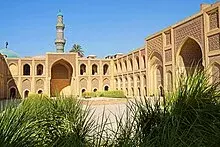Abbasid Palace

- The Abbasid Palace is one of the last surviving remnants of the glorious Abbasid era in Baghdad. Built in the 12th century, this architectural marvel stands as a reminder of the city's historical significance as a center of knowledge, culture, and governance. The palace, located near the Tigris River, is often associated with Caliph Al-Nasir and showcases the unique design elements of Abbasid architecture, including pointed arches, intricate brickwork, and decorative stucco carvings.
- While the palace no longer serves as a royal residence, its historical and cultural significance remains intact. Visitors can admire the grand halls and expansive courtyards that once housed Abbasid rulers and scholars. The walls, though weathered by time, still carry traces of the intricate calligraphy and geometric patterns that defined Islamic architecture during the medieval period.
- One of the most fascinating aspects of the Abbasid Palace is its connection to Baghdad’s intellectual past. The city was once home to the House of Wisdom (Bayt al-Hikma), where scholars from different cultures translated and preserved ancient knowledge. Though the House of Wisdom itself no longer stands, the palace serves as a symbol of that golden age.
- Today, the Abbasid Palace is a popular attraction for historians, architecture enthusiasts, and tourists seeking a glimpse into Iraq’s medieval past. Its location near other historical sites, including the Mustansiriya School and Al-Mutanabbi Street, makes it an essential stop for those exploring Baghdad’s cultural heritage.
